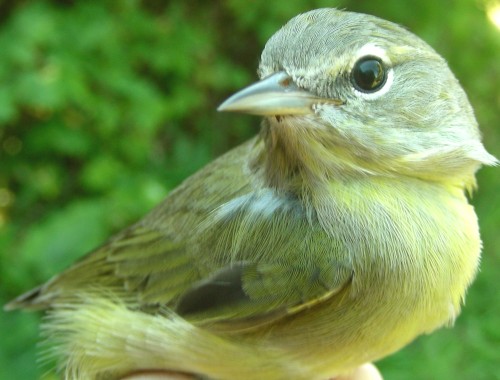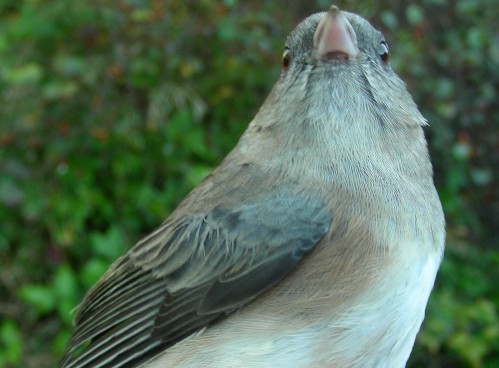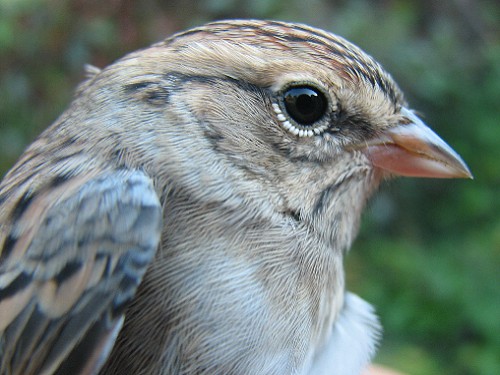|
McGILL BIRD OBSERVATORY |
|||||||||||||||||||||||||||||||||||||||||||||||||||||||||||||||||||||
Welcome
to the McGill Bird Observatory weekly report.
Click here for a complete listing of our archives.
Banders-in-charge: Marie-Anne Hudson, Barbara Frei Assistants: Jean Beaudreault, Veronik Campbell, Sophie Cauchon, Shawn Craik, Diane Demers, Jean Demers, Lacey Hébert, Gay Gruner, Helen Leroux, Alessia Kockel, Barbara MacDuff, Francine Marcoux, Eve Marshall, Mike Mayerhofer, Heather Milligan, André Pelletier, Greg Rand, Katleen Robert, Clémence Soulard, Rodger Titman, Shona Watt Notes: With an influx of migrants late in the week, the number of birds staging at MBO went up considerably. Unfortunately with the sun shining brightly, these same birds didn’t always end up in our nets, opting to spend their time kicking up the fallen leaves under the hawthorns (White-throated Sparrows), gleaning insects off the leaves still attached to the taller trees around the property (warblers) or flying high around the site in small groups (Common Grackles). Even in our seventh week we managed to band some new species of warbler: our first Orange-crowned and Western Palm Warblers of the year, as well as our first Black-throated Green Warbler, which had been hanging out near the nets for several days before actually being caught. We hope the others will follow its example! Other species banded this week for the first time this fall were Winter Wren, Chipping and Savannah Sparrow. New species observed this week include Broad-winged Hawk and a single Spotted Sandpiper. We keep saying how similar some years can be, but when we looked at last year’s week 7 report, we nearly fell off our chairs: Winter Wren, Savannah Sparrow, Orange-Crowned Warbler, Yellow Palm Warbler (pretty close to a Western…) were all banded for the first time last season during week 7 as well. Raptor migration is definitely underway, with several kettles of Broad-winged Hawks swirling over MBO this past week. Add to that the several low-flying Sharp-shinned (of which two were banded!), Cooper’s, Red-shouldered and Red-tailed Hawks, as well as the occasional Northern Harrier and Merlin, and we consider our raptor diversity to be quite good … though we’re still looking forward to the Turkey Vulture and Osprey flights of last year. Toss in an eagle or two and we’ll be thrilled! The top 10 species banded this week has almost flipped itself on its head compared to last week. White-throated Sparrows are still holding their own, well in the lead at number one, but the rest of the top five were last week’s bottom five! It’s easy to move around the table when the number of birds banded is so low – we’re hoping migration will peak soon so we can have those hundred bird days that keep us moving the entire morning. If you’re dying to see some “confusing fall warblers”, it’s not too late: half of our top ten is still composed of warblers. The vireo wave has apparently passed, with the Red-eyed Vireo not even appearing on the list after being in fourth position last week. If we look at last year’s report at this time, there’s one glaring difference (and a direct contradiction to our statement at the end of the first paragraph): the number of Yellow-rumped Warblers is basically nil right now, when they were the most abundant species banded by far last year. An excellent illustration of the sporadic, wave-like and sometimes completely unpredictable nature of migration! Of note, despite bird numbers remaining much lower than last year, diversity continues to be high, with two more species banded (and also two more observed) than at this point in fall 2006.
The top 10 observed list has been rearranged a little since last week, with the White-throated Sparrow leaping up from seventh to second position. The rest of the crew are pretty much the same, but have been shuffled around somewhat. For the first time this season (and as far as we can recall, ever), we now find a raptor in the top ten, with Broad-winged Hawks taking the last spot.
|



